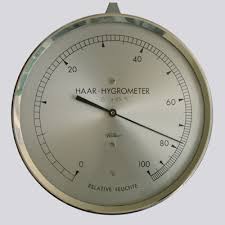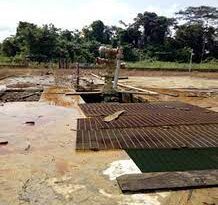Meaning and Measurements of Humidity
Humidity is another subset of the hydrological cycle, and its knowledge is important to the study of hydrology. Humidity is concerned with the vapor state (gas) of water in the atmosphere. This article will focus on the definition of humidity, specific and relative humidity, and its measurement.
What is Humidity?
Humidity refers to the amount of water vapour present in the air. The amount of water vapour present in the air varies widely from place to place and time to time. It ranges from almost nothing in the cold, dry air of arctic regions in winter to as much as 4 or 5 percent of a given volume of air in the warm wet regions near the equator (Strahler and Strahler, 2006).
Understanding humidity and how the moisture content of air is measured involves an important principle, which states that the maximum quantity of moisture that can be held at any time in the air is dependent on air temperature.
Warm air can hold more water vapour than cold air. For example, air at room temperature (200C) can hold about three times as much water vapour as air at freezing point (00C).
Specific Humidity
Specific humidity is the actual quantity of water vapour held by a parcel of air. This measure is important because it describes how much water vapour is available for precipitation. Specific humidity is stated as the mass of water vapour contained in a given mass of air and is expressed as grams of water vapour per kilogram of air (g/kg).
Specific humidity is often used to describe the moisture characteristics of a large mass of air. For example, extremely cold dry air over arctic regions in winter may have a specific humidity as low as 0.2g/kg.
In comparison, the extremely warm, moist air of equatorial regions often holds as much as 18g/kg. The total natural range on a worldwide basis is very wide. In fact, the largest values of specific humidity observed are from 100 to 200 times as great as the smallest (Strahler and Strahler, 2006).
Specific humidity is a yardstick for a basic natural resource – water. It is a measure of the quantity of water in the atmosphere that can be extracted as precipitation. Cold moist air can supply only a small quantity of rain or snow, but warm, moist air is capable of supplying large amounts.
Another way of describing the water vapour content of air is by its dew-point temperature. If air is slowly chilled, it eventually will reach saturation. At this temperature, the air holds the maximum amount of water vapour possible.
If further cooling continues, condensation will begin and dew will form. The temperature at which saturation occurs is therefore known as the dew-point temperature. Moist air will have a higher dew-point temperature than drier air.
Relative Humidity
Relative humidity is a ratio (expressed as a percentage) of the amount of water vapour that is actually in the air compared to the maximum water vapour possible in the air at a given temperature.
Warmer air increases the evaporation rate from water surfaces, whereas cooler air tends to increase the condensation rate of water vapour to water surfaces. Because there is a maximum amount of water vapour that can exist in a volume of air at a given temperature, the rates of evaporation and condensation can reach equilibrium at some point; the air is then saturated with humidity.
Relative humidity varies because of evaporation, condensation; or temperature changes. All three affect both the moisture in the air (the numerator) and the water vapour possible (the denominator) in the air. The formula for calculating the relative humidity ratio and expressing it as a percentage is simply.
As earlier stated, air is saturated when the rate of evaporation and the rate of condensation reach equilibrium – that is 100% relative humidity. In saturated air, the net transfer of water molecules between a moisture surface and the air reaches equilibrium.
Read Also : Methods of Disposal of Waste Pesticide Containers
Saturation indicates that any further addition of water vapour or any decrease in temperature that reduces the evaporation rate will result in active condensation (clouds, fog, or precipitation). Therefore, relative humidity indicates the nearness of air to a saturated condition and when active condensation will begin.
The temperature at which a given mass of air becomes saturated is the dew-point temperature. In other words, air is saturated when the dew-point temperature and the air temperature are the same.
When temperatures are below freezing, the term frost point is sometimes used. A cold drink in a glass provides a common example of these conditions. The water droplets that form on the outside of the glass condense from the air because the air layer next to the glass is chilled to below its dew-point temperature and thus is saturated (Christopherson, 2007).
During a typical day, air temperature and relative humidity relate inversely – as temperature rises, relative humidity falls. Relative humidity is highest at dawn, when air temperature is lowest.
If you park outdoors, you know about the wetness of the dew that condenses on the car overnight. Relative humidity is lowest in the late afternoon, when higher temperatures increase the rate of evaporation.
Measurement of Humidity
Relative humidity is measured with various instruments. The hair hygrometer is based on the fact that human hair changes as much as 4% in length between 0% and 100% relative humidity. The instrument connects a standardized bundle of human hair through a mechanism to a gauge. As the hair absorbs or loses water in the air, its change in length indicates relative humidity.
Another instrument used to measure relative humidity is a sling pyschrometer. This device has two thermometers mounted side by side on a metal holder. One is called the dry-bulb thermometer; it simply records the ambient (surrounding) air temperature.
The other thermometer is called the wet-bulb thermometer, because it is moist. The psychrometer is then spun by its handle; after a minute or two, the temperature of each bulb is compared on a relative humidity (Psychrometric) chart, from which relative humidity can be determined.
The rate at which water evaporates from the wick depends on the relative saturation of the surrounding air. If the air is dry, water evaporates quickly, absorbing the latent heat of evaporation from the wet bulb thermometer, causing the temperature to drop (wet-bulb depression).
In an area of high humidity, much less water evaporates from the wick, resulting in a smaller temperature difference between the two thermometers.
In summary, having gone through this article, you should by now be well informed of the close relationship that exists between humidity and precipitation – a significant component of the hydrologic cycle.
Humidity is a measure of the quantity of water in the atmosphere that can be extracted as precipitation. In other words, the amount of precipitation received in a given area is dependent to a very large extent on the moisture characteristics of the air mass.
Humidity refers to the amount of water vapour present in air. Warm air holds much more water vapour than cold air.
The dew-point temperature of a mass of air is the temperature at which saturation will occur. The more water vapour in the air, the higher is the dew-point temperature.
Relative humidity depends on both the water vapour content and the temperature of air. It compares the amount of water held by air to the maximum amount that can be held at that temperature.



